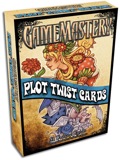Sign in to create or edit a product review. Heresy, Gorbacz The Snarky Pazio Fanboy reviews a 4e product! Run to the hills and call the guys from the 4e subforum! Scott Betts, save us! Ahem. DISCLAIMER: I don't play 4e. This isn't a review of monster book, the adventure, or anything else apart from... ... the die-cut monster tokens. Yes. I bought it just for them. They're excellent - sturdy, pretty and most important, there are hundreds of them. After trying many solutions for representing monsters on the battlemat - from minis (tonight this Giant Beetle stands in for a beholder *wink wink*), Fiery Dragon printable counters (hey, is that a hole in my pocket or is printing things on cardboard somewhat expensive?) and Paizo paper minis (see above) and none have satisfied me. And now that dreadful abomination of a company, a corporate slave to Hasbro overlords, makes a product that wins hands down in the category. One star off for me having to pay for things that are useless for me (4e material, WotC could really sell the counters as standalone product) and for the fact that the biggest size is Huge (not that much of a problem, but still). I eagerly await more products like this one and I hope that somebody at Paizo takes a clue from this - I know that The Golem Can Do It Better! 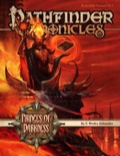
Pathfinder Chronicles: Book of the Damned—Volume 1: Princes of Darkness (PFRPG)Paizo Inc.Print Edition Unavailable Add PDF $15.99 Non-Mint Unavailable Why it's so hard to like this book?First volume in Books of the Damned - a series on Evil outsiders - concerns with Devils, the good old manipulative LE schemers of the D&D world. Wes Schneider tackles the job of improving over 3.5ed Fiendish Codex II, which wasn't all that great. Let's see how it goes. Chapter 1 describes the archdevils (Asmodeus included) and their realms, the layers of hell. No statblocks are given, due to Pathfinder not having epic rules to handle that yet. Chapter 2 provides information on the ecology of the regular devils, as well as some information on other denizens of hell. I really liked the Whore Queens idea, I must admit. Chapter 3 presents rules for mortal involvement with devils. Infernal contracts, devil binding, fiendish spells and magic items and a Prestige Class - the Diabolist - are all here. I think it's the best chapter in this book, one that I've actually used. Chapter 4 is the compulsory bestiary section. Four new devils to pit against your players. Now, what's my conclusion? Honestly, the style of writing puts me off. The author sinks into Dante/Milton inspiration somewhat too deeply and the result borders on purple prose, with superfluous passages that feel like taken out of some Romantism novel. The maledictions of the archdevils and their personal histories and drama are are all very well thought out, but this book has very little substance for a GM that runs something less...dramatic. I didn't get that much use out of this book as I hoped for. For a primer on how to write such book as to make it a worakble source for the GM, refer to the next volume in series, Lords of Chaos, which is far better. 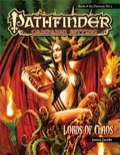
Pathfinder Campaign Setting: Book of the Damned—Volume 2: Lords of Chaos (PFRPG)Paizo Inc.Print Edition Unavailable Add PDF $15.99 Non-Mint Unavailable Great book on Pathfinder demons.The second volume of "Books about Evil Outsiders" concerns with demons. An obvious follow-up to the devil book, Lords of Chaos was written by Paizo's resident demon expert. The book begins with descriptions of major demon lords in Pathfinder Campaign setting, beginning with the demon-goddess Lamashtu and featuring faces both familiar (Orcus, Pazuzu). Each description provides information on the lord him/her/itself, domain, worshippers and a "statblock" with rules on boons and obediences. Two things need to be made clear here. Several D&D demon lords were not carried over due to IP reasons (Graz'zt, Lloth). However, a few made their way into Golarion, be it due to being based on real world mythology (Pazuzu) or being open content thanks to Tome of Horrors (Orcus, Jubilex). However, majority of demon lords presented here are brand new. There are no demon lord statblocks due to the obvious reason of Pathfinder not having epic rules for handling them yet, as well as space concerns. Chapter two provides brief background on every regular demon types, as well as basic information on "nascent" demon lords, the "almost-there" bad guys such as Treerazer. Chapter three details rules for demon worships, including fulfilling the obedience rituals and gaining demonic boons, and presents a new PrC - demoniac. Chapter four is the bestiary section, with four new demons to threaten your players with. Overall, this book stands heads and shoulders above volume 1. The writing is excellent, evocative, balls-to-walls scary at times. James Jacobs "loves" demons, and it shows. You can feel him putting his favorite ideas on paper just like it could be felt with WotCs Fiendish Codex. Two thumbs up! 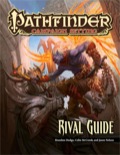
Pathfinder Campaign Setting: Rival Guide (PFRPG)Paizo Inc.
Add
Print Edition
Add PDF $15.99 Non-Mint Unavailable What an NPC book should be!Earlier I reviews the NPC Guide, which I was less than enamored with, putting it mildly. Paizo's first attempt at an NPC gallery missed the spot, how about take two? This book presents 10 adventuring parties, each made up of 4 members who can serve as antagonists (mostly) and/or allies (in few cases). Each party gets an introductory write-up detailing their history, motives and modus operandi, followed by short descriptions, complete statblocks and evocative art for each persona. I'm happy to report that this book improves over NPC Guide in about every conceivable way. The NPCs are mostly high level, meaning that Rival Guide is of much more use for a harried GM. Each party described in this book isn't just a bunch of stats, however. These groups have chemistry, motivations, quirks, relationships (including at least one homosexual pair and a few... odd couples to say at least) and flavor. But most importantly, several of the parties were written with specific Paizo APs in mind, allowing the GM to easily insert those NPCs in their campaigns. Of course they work perfectly fine in any other environment, but this support for existing adventure paths is very welcome. Finally, Rival Guide contains several new magic items, spells, templates and feats used by the NPCs. This helps make the rival groups even more unique and memorable. All in all, one of the best CS line books, ever. Great for any GM, regardless of running games in Golarion or not. You won't be disappointed! 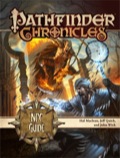
Pathfinder Chronicles: NPC Guide (PFRPG)Paizo Inc.Print Edition Unavailable Add PDF $15.99 Non-Mint Unavailable Could have been far better.Every GM's nightmare: NPCs. Coming up with believable, memorable and challenging personalities for PCs to interact with is an art, learned over years of experience and gaming. But that's just half of the challenge, since we're talking D&D/PF here, we need to tackle the daunting NPC statblocks, full of abilities, spells and other things that require time and energy to create. So it would be a great thing to have some help here, right? A book with pre-generated NPCs is always a good idea. As long as the idea is well executed, that is... NPC Guide consist of 3 chapters. Chapter 1, titled "Named NPCs" contains 30 fully-fleshed NPCs, each one with a portrait, backstory, statblock and suggested "boons" which they may bestow upon PCs. Chapter 2 presents 50 generic NPC statblocks - no fluff, just stats. Finally Chapter 3 describes Paizo staff PCs from their personal campaigns. While the quality of writing, artwork, ideas and fluff is great, the book suffers from two serious problems, which somewhat cripple it's usefulness. Firstly, almost all the statblocks presented in NPC Guide are low level. Only a couple of named NPCs are above CR 5 and all of the generic statblocks are below it. This is a major blow, because arguably the most time-consuming and demanding part of NPC creation is the science of statblock building. The second problem is that there isn't really anything in the way of new rules elements (items, spells, feats, etc.) to support the NPCs. In fact, being mostly low-level, they tend to be rather bland on the crunch side. While it's very nice to see dozens of both common, generic NPCs and more fleshed-out personalities, I fear that this wasn't exactly what a harried GM is after. Knocking together a level 3 NPC isn't that hard (especially with Hero Lab around), but the high level statblocks are killers. Luckily, Paizo seems to have realized the error, and the recent Rival Guide is everything such book should be. 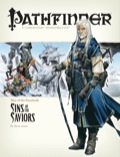
Pathfinder Adventure Path #5: Sins of the Saviors (Rise of the Runelords 5 of 6) (OGL)Paizo Inc.
Add
PDF
Print Edition Out of print Non-Mint Unavailable Soild dungeon crawl, uneven at timesThe fifth instalment of Rise of the Runelords is a straight up dungeon crawl. The adventure quickly sends the PCs into a massive complex, divided into 7 wings, each themed after a deadly sin of ancient Thassilon. Well, make that 5 wings - the adventure is a clear victim of limited space available in a 96-page book, and 2 wings are pretty much "castrated". On a plus side, it allows the DM to plug in any dungeons of his own creations or from other sources. The remaining part of the adventure is old-school deadly, bringing back memories of killer dungeon crawls from D&D history. The quality of encounters and locales ranges from excellent to "meh". There are several nice bits of backstory scattered here and there, but the overall link with the main plot of the campaign is rather hazy. The adventure does a good enough job of introducing the players to Thassilonian magic, culture and history firsthand, and sets the tone for campaign finale. Yet, the adventure didn't lodge itself in memory of me and my group as much as the first three RotRL modules did. Of course, the backup material is of prime quality. The article on Lamashtu, the evil demon queen, was wickedly - and at times revoltingly - fun to read. 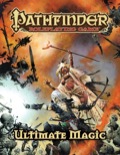
Pathfinder Roleplaying Game: Ultimate Magic (OGL)Paizo Inc.Hardcover Unavailable Add PDF $19.99 Non-Mint Unavailable Good book with a few problems.Here comes the second PFRPG splatbook after APG, this time focused on magic-using classes. First thing that leads to me knocking a star off right away - 4 classes (Fighter, Rogue, Barbarian, Cavalier) are out of luck here, as no material for them appears in UM (barring a few feats). That wouldn't be that bad if it wasn't for the news that Ultimate Combat will feature new stuff for ALL classes, meaning that martials get a bit shafted. Nothing major, but had to get that off the chest. So, the book itself. Here it goes: CHAPTER 1: Spellcasters Opens up with Magus, the new base class. Magus is a med-BAB bard spell progression class which matches melee combat with offensive spellcasting. I'm pleased to say that it is very well written. Suggestions from open playtest were included and refined. The class is solid, and even features a few new archetypes (including Bladebound for all Elric fans out there). Right next are new options for existing classes: Alchemists made it out like bandits with new discoveries and archetypes. The class was solid in APG and goes firmly better in UM. Tumour familiar and parasitic twin are creepily cool. Bards get Masterpieces, which are somewhat underwhelming power-wise, and a few new archetypes. Wish they got more, Bards have great potential. Clerics get variant channelling, which is great if you want to replace the standard healing/damaging for something more flavorful. Several archetypes are present, including the much-demanded Cloistered Cleric. No new domains, sadly. Druids are in for a treat. New domains, new animal companion and a big bunch of archetypes. Dragon Shamans ahoy! And now yes you can have a Spider companion. Yuck. Inquisitors have now an option of swapping out the domain for a new feature called, surprise, Inquisitions. They also have a few new archetypes. Solid work here. Monks get vows which are ... disappointing to say at least. Ironically enough, the book includes a PF version of vow of poverty which, honestly, sucks. The other vows aren't that much better. Monks get only one archetype which is quite good, but not enough to make Monk players happy. Oracles have five new mysteries and a couple archetypes. No new curses. I'd really love more mysteries, I still lack a few concepts here. Paladins can now take the Oathbound archetype, which gives them access to several thematic oaths. Rangers get the Trapper archetype, which is not all that great sadly. Nothing else besides, another class that should rather be looking forward to Ultimate Combat. Sorcerers - new bloodlines and two archetypes that deal with bloodline mechanics. Nothing dramatic here. Summoners are another class which went to town for shopping. New base form for Eidolon, new evolutions and new archetypes, including the oft-requested "mass summoner" and my personal fave, the Synthesist. Guyver time! Witches get a complete package - new hexes, new patrons and new archetypes. Solid expansion of APG material. Finally, Wizards. Wizards get a single archetype and 2 elemental wizard schools, but the party is at Arcane Discoveries which may replace bonus feats. Some of those are really powerful. CHAPTER 2: Mastering Magic Contains new and variant rules. Spellblights are magic-related afflictions which can hinder a spellcaster in new ways. Spell Duels chapter details just that, spellcaster duels. The next section focuses on binding outsiders, another feature that's underdeveloped in core rules. New rules for construct creation and customization are REALLY cool. New familiars are always welcome. Coming up next are sample spellbooks, which are amazingly useful but mired by editing errors that left several spells "orphaned". Finally, the section on spell design offers some insight into just that. Not my cup of tea, but fans of poking inside designer's minds will be happy. CHAPTER 3: Feats The compulsory feats chapter is quite large and includes dozens of new ways to customize your character. The feats are mostly in line with Core and APG, a few are somewhat underpowered and a single one (Antagonize) clearly needs better number crunching. A feat called "Die For Your Master" made me chuckle. CHAPTER 4: Words of Power This chapter describes the new, alternate magic system based around customized spells made up of power words. I'd love to elaborate on this, but since the concept itself doesn't really interest me, I didn't give this chapter a honest read. You might find it useful if you like experimenting, tho. CHAPTER 5: Spells Another obvious addition: new spells. Scores of them, of course. There are several really fun, innovative and clever spells here and I found this chapter a refreshing read. A spell called mad monkeys wins the day for me, nothing beats summoning a swarm of crazed gibbons against your foes. CONCLUSION This is a solid splatbook. Much broader than WotC "Complete" splats, with several thematic ideas that draw upon mythology, history and pop culture to liven up your PF game. Yet, three things contribute to knocking off one star: - the aforementioned lack of love for non-caster classes. I realize the book is called Ultimate Magic, but the caster-martial divide in D&D is well known and one could hope for something to help bridge it. - quality control is worse than in Core and APG. I don't mind typos, but a couple of things are either badly written (Antagonize), poorly thought out (Monk vows) or victims of editing/development errors (Spellbooks). It's not bad enough to cause discomfort, but it is visible enough to request more tight supervision of future books. - purely optional content. I'm not a fan of stuff which I will, objectively, never get to use. An entire chapter of UM - Words of Power - is pretty much lost on me and I would much prefer for it to sit in an "Unearthed Arcana" type of book. The spell design chapter is also slightly guilty of this. I recommend this book, you'll have lots of fun from it and it will enrich your experience no matter if you are a player or GM. But I also recommend Paizo to step up and maintain their quality standards found in other books. 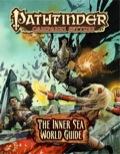
Pathfinder Campaign Setting: The Inner Sea World Guide (PFRPG)Paizo Inc.Add Hardcover $49.99 Add PDF $29.99 Non-Mint Unavailable Non-Mint Unavailable Pathfinder Campaign Setting gets an update3 years ago Paizo released the first edition of Pathfinder Campaign Setting. With the original book out of print, a new ruleset (PFRPG) and several ideas on how to refine the setting, the team lead by James Jacobs and Erik Mona set out to refine their tome of Golarion lore. ===PRESENTATION=== A solid sewn hardcover book with over 320 pages in full color. As usual, the artwork and layout is above and beyond. Paizo books have their unique art style, and it shows. There are several navigational aids, including a comprehensive index. The book is a pleasure to look at and use. Of special note is the cartography. Both the new global poster map and the individual country/are maps are great, crisp and clear. Rob Lazzaretti went above and beyond here. Bonus points with me: regional maps highlight the area described and "gray out" the surroundings, much like the Eberron maps. ===CONTENT=== The new Campaign Setting books offers a comprehensive look at the Inner Sea region of world called Golarion. Paizo's setting can be described as a nostalgia-infused "kitchen-sink" of historical, mythological and fantasy archetypes, mixed with several unique creations and sprinkled with some techno-fantasy and Lovecraftian bits. Despite the "one size fits all" mentality of designers who tried to fit as many classic genre tropes in one world - from Ravenloft-ish horror to Arabian Nights and everything in between - the world feels coherent, seamlessly joining elements which seem odd at the first glance, yet make perfect sense once you read about them. It's a setting for everyone, unique yet universal enough to encompass virtually every style of fantasy and reflecting all the classic historical periods. Any reader well-versed in D&D settings will instantly notice Greyhawk vibes flowing from the book, as well as a dash of Planescape and few nods to other classic themes of the game. It's a setting of modern nostalgia, looking back to the history of D&D far enough to reach and take the best elements yet close enough to the modern day as to keep things fresh and interesting for a reader unfamiliar with the "old times". The book opens with a chapter on races. What strikes here is the anthropocentrism - humans dominate the setting, and several human ethnicities are described. Demihuman races get their share, too - each "core" D&D race is described shortly. There's also mention on how the fan-favorite humanoid races, such as tieflings or drow, fit into the setting. The next chapter is The Big One - Inner Sea, with 4-page description of each country/region. It opens up with a detailed timeline, and follows with a gazetteer on over 40 areas, each provided with a map and information on history, government and important locations. The chapter ends with a short glance on other continents of the setting (eg. the equivalents of Asia and Americas), followed by a quick description of forgotten/lost empires and areas. Coming up next is the deities chapter. The 20 core gods of the setting are presented with short descriptions, along with quick write-ups on the minor deities. This chapter also describes the cosmology of the setting, a Great Wheel planar arrangement that borrows heavily from the rich history of D&D and the Planescape setting. A chapter of the book which I particularly enjoyed is the next one, entitled Life. It contains information on time, climate, languages, society, trade, fauna, flora and technology of the setting. One very important part of it is the Society section, it lays down basic foundations on how prevalent magic is in the world, and how do the “power levels” of NPCs factor in. Those are very important design decisions, and I’m glad that they are described directly. Coming up next is the Factions chapter, describing the most important organizations and groups such as Pathfinder Society or Hellknights. Nothing revolutionary here, just a solid read. The Adventuring chapter contains the “crunch” for players and GM’s alike: prestige classes, feats, spells, equipment and magic items. Again, a standard fare for a campaign book, although I really love the Low Templar prestige class, both for the lore and crunch. The final chapter, Monsters, presents a couple of setting-specific creatures. I must say that the choice is somewhat puzzling, I wouldn’t exactly call Aluum or Calikang iconic monsters of Golarion. I guess it’s because several such monsters already made their way into Bestiary 1 and Bestiary 2, and overlap wouldn’t be a good thing. The book concludes with a handy index and a poster map. The map is a scaled-down version of the massive Inner Sea Map Folio, and does the job very well. Slightly too colorful for my tastes – I prefer the more subdued look, but then again colorful maps do a better job of showing where’s sand and where’s a swamp. ===CONCLUSION=== The team at Paizo took their old campaign settings and polished it, smoothed the rough edges, updated everything to the new rule set and packed it all in a truly gorgeous layout. For somebody who doesn’t have the first edition, I would recommend to buy this book now. Those who already have the old campaign setting should consider purchasing the hardcover or at least the very affordable PDF. It’s good enough to warrant replacing the first one, but your mileage may vary. 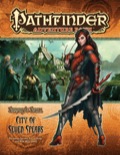
Pathfinder Adventure Path #39: City of Seven Spears (Serpent's Skull 3 of 6) (PFRPG)Paizo Inc.
Add
PDF
Add
Print Edition
Non-Mint Unavailable Not that impressive.OK, having read the module back and forth all I can say is that I'm disappointed. The fact that the number of authors grew over time (first Kevin, then Kevin and James, and finally Rob too) was an indication that something isn't exactly on the ball here, and my fears were right. This adventure is ... well, it isn't as messy as Memory of Darkness, but it's a wasted potential. A discovery of ancient city in the jungle sounds like a cool idea. Hell, this was done before, both by Greg Vaughan with Xin-Shalast and Wolfgang Baur with Crucible of Chaos. Something went wrong with this module. Instead of awesome exploration and wondrous sights, we get a hackfest. Each district of the city is just about wading across a sea of blood and guts. Honestly, this feels more like a WotC 4e adventure than a Paizo module. There are a few interesting bits here and there, but they don't liven up the adventure enough. To add insult to injury, while we do get a big nice map of Sanveth-Yi, there are no location maps to speak of. This is horrible for me, because it means that I have to take my time off and do them myself. I buy Paizo APs to save time, and so far I was served a wonderful plate of cool maps that cut my DM work considerably. Not here. The support articles are of the usual excellent quality, and a few cool opponents/ideas in the module rescue it from being a total letdown, but still - not a fan. This card deck is one of the better prop/accesory ideas since, erm, Paizo's own Harrow Deck. Allowing players to influence the narrative in a cool and unusual way is great. Especially as it helps me draw LARP/narrativist players to Pathfinder! Great idea, great execution. Also, whoever references '80s Lion Rampant products by Tweet and Rein(dot)Hagen gets a point with me. 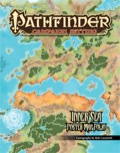
Pathfinder Campaign Setting: Inner Sea Poster Map FolioPaizo Inc.
Add
Folio
Add PDF $9.99 Non-Mint Unavailable I have a wall. It was a sad wall, empty and devoid of beauty. Now it will be bare no more, for the most awesome RPG setting map ever will appear there. I love it. I love things I can show to the players and make them go "ooooh". The map of Sandpoint was one such thing, and this is another. Marvelous work from both designers who put all those locations together and Maestro Lazaretti. Incredible. 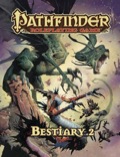
Pathfinder Roleplaying Game: Bestiary 2 (OGL)Paizo Inc.Hardcover Unavailable Add PDF $19.99 Non-Mint Unavailable Paizo's good approach to monster books continues.If there is the one type of RPG book that nobody ever has enough of, it’s the monster books ! Bestiary 2 for Pathfinder RPG was a no-brainer, so here it is. ===PRESENTATION=== A solid sewn hardcover book with over 320 pages in full color. The artwork is even better than in the first Bestiary. This is perhaps the prettiest monster book in d20 history. There are several navigational aids, including indexes and CR tables. The book is a pleasure to look at and use. ===CONTENT=== Bestiary 2 was certainly a challenge to put together. The first one was rather easy – update as many 3.5 SRD monsters as possible, throw in some sprinkling of retro and Pathfinder critters, voila. Bestiary 2 has set out to meet several ambitious goals: 1. Updating the leftover SRD monsters. Most of them are in Bestiary 2 – Red Reaver, Rast, Tendriculous and several more. A few (Tojanida, Delver) had the dubious honor of being featured in Misfit Monsters Redeemed instead. 2. Presenting as many monsters from Pathfinder Adventure Path and other 3.5 Pathfinder sources as possible. In general, most of the beasties from the first three APs and a few from Legacy of Fire are in Bestiary 2 (including such Paizo staples as Rune Giants, Pugwampis and Lamia Matriarchs). 3. Outsiders. Beings from the great beyond are the main theme of the book, with roughly 1/3 of the monsters coming from the many corners of the multiverse. First off, the leftover 3.5 outsiders are back (hello, Inevitables). Next, the classic groups (demons, devils, angels, archons, elementals) get a few new members such as the classic quasi-elementals.
4. Filling conceptual niches. The default 3.5 monster gallery is rather short on fey, plants and constructs. Paizo took steps to remedy that with several new monsters of each type. 5. Finally, New Stuff. Paizo adamantly holds to their legend lore and cryptozoology sources, and it shows. Mongolian Death Worm, Charybdis, Scylla, Jabberwocky, Brownie … the list goes on. Oh, and Dragons. Including Neutral Dragons and the very-not-neutral Umbral Dragon and Ravener (Paizo’s Dracolich). Also, many monsters are carried over from Necromancer Games’ Tome of Horrors and Green Ronin’s Book of Fiends, both highly acclaimed 3.5 era bestiaries. 6. Higher CR’s. The Challenge Ratings top at 23 and there are several high-level monsters to challenge experienced groups. 7. Hippogriff. Just that. And how’s that ! The monsters are consistently presented in 1 page = 1 monster format, making the book far easier to use than the 3.5 MM. The universal monster rules system is here as well, with all the common special rules placed in one chapter. Monster advancement now features CRs up to 25. ===CONCLUSION=== This book easily matches, and in some areas (artwork !) comes ahead of Bestiary 1. An excellent addition to any 3.5 library. You won’t be disappointed ! 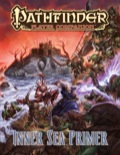
Pathfinder Player Companion: Inner Sea Primer (PFRPG) Print EditionPaizo Inc.
Add
Print Edition
Add PDF $9.99 Non-Mint Unavailable Excellent introduction to GolarionThis book was badly needed for some time already. So far, the only solid intro book for Golarion was the Gazzetter, which was a slight bit too long for wooing new people. Here comes the Inner Sea Prmier, written by industry veteran Colin McComb. The most important question is: does it do the job ? Can it be used to introduce new players to the PF campaign setting ? The book starts with a full page map of the Inner Sea region. This is the first Golarion map with clearly visible country/region boundaries and capitals marked, which is a great plus. On a flip side, it's a bit too brightly colored. Coming up next is a short timeline. Excellent move, as the CS timeline is kinda intimidating. This one details the major events without getting sidetracked by Tian Xia emperors discovering the use of a teapot. Then comes the bulk of the book - short descriptions of countries/areas, each has half a page. Apart from crucial facts and background, each region has two traits for players. This is a great move, as it helps flesh out a PC from given area from the get go. There is also a short mention of Bad Places, such as Darklands or the Worldwound. The next chapter gives us three archtypes for melee classes. Archetypes are something that I absolutely adore, as they are the 2e kits done right. Kudos for giving us that instead of PrCs. The following chapter details the major and minor gods of the setting. After this comes the magic chapter, with three variant Wizards. Finally, the races and ethnicities of Golarion are briefly described. How do I feel about this book ? I think it's a great introduction to Golarion, enhanced by Colin's excellent writing and evocative map, icons and artwork. It's great for what it's supposed to do. My only minor complaints are lack of new archetypes for divine/skill classes and no section on The Great Beyond. However, those are minor issues and don't knock a star off my final score. 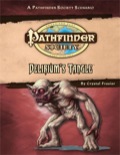
Pathfinder Society Scenario #45: Delirium's Tangle (PFRPG) PDFPaizo Inc.Our Price: $3.99 Add to CartExquisiteOK, I'll be brief - can the person in charge at Paizo issue more things for Crystal Frasier to write, because the gal is rapidly becoming one of my favourite authors. This adventure is so wonderfully smooth, coherent and feels like a charm to read to run. 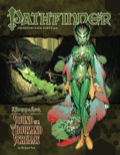
Pathfinder Adventure Path #36: Sound of a Thousand Screams (Kingmaker 6 of 6) (PFRPG) Print EditionPaizo Inc.
Add
PDF
Print Edition Out of print Non-Mint Unavailable PettiliciousOnce again, Richard Pett proves his amazing skill at crafting adventures. Twisted fey realms, winged owlbears, Worm That Walks, ideas and encounters that will throw the players reeling in shock and awe. Also, great support article about the insane First World, by James "Kaer Maga" Sutter. An astounding finale of a great adventure path. Huzzah ! 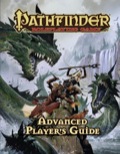
Pathfinder Roleplaying Game: Advanced Player's Guide (OGL) HardcoverPaizo Inc.Add Hardcover $44.99 Add PDF $19.99 Non-Mint Unavailable THE crunchbook.I wrote a rather long review, but found it too long to fit here. So I'll be brief: this is the best player option book out there in 3.5 history. The idea of class archetypes is worth the asking price alone, but all other aspects presented here are outstanding as well. Buy it, you won't be disappointed. And now excuse me, I'm off to roll my Sacred Tattoo Half-Orc Zen Archer Monk/Brutal Pugilist Barbarian. 
Pathfinder Chronicles: Kingmaker Poster Map FolioPaizo Inc.Print Edition Out of print Add PDF $9.99 Map Folios, finally usefulI used to loathe Paizo map folios with a burning passion, temporarily cancelling my subscription every time one of those turned up on the horizon. Speaking bluntly, the old folios were mostly useless, except for a map or two. So naturally I was curious as to how will the New, Improved and Revamped folio format turn out. The verdict: it's good. We get 4 hex maps of the Kingmaker area - rather cruciual for the AP, given it's nature. We also get 2 maps of settlements: Varnhold and Pitax. Quality is great, as usual. Rob is a maestro of mapmapking and there's no match for his craft. What knocks a peg off the score ? There really should be a map of Drelev here. Apart from that, it's good that folios are finally useful. Thanks for listening to our crtique, Paizo ! 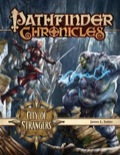
Pathfinder Chronicles: City of Strangers (PFRPG) Print EditionPaizo Inc.Print Edition Unavailable Add PDF $15.99 Non-Mint Unavailable Great classic-style location sourcebookI would like to echo the previous reviews - this book is both full of amazing ideas and hooks and yet vague enough to leave space for DM to work his stuff in. And it's a very important quality, given that Kaer Maga is the perfect sidetrek for the first three APs. In partciular, GMs running CotCT should grab this book ASAP. After a long string of collaborative work in the Chronicles line, it's great to see a one-man book - it has much more focus and personal imprint. My only nitpick is - why no poster map ? 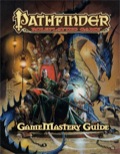
Pathfinder Roleplaying Game: GameMastery Guide (OGL)Paizo Inc.Hardcover Unavailable Add PDF $19.99 Non-Mint Unavailable Swiss Army Knife for the DMThis book is supposed to be useful for both veteran GMs with three bookshelves of 3.5 material and new Pathfinder GMs who don't have such experience nor library. It's hard to do a good book for both those audiences, and I think that Paizo pulled it out perfectly. A veteran will likely find some of the GMG material "old story", while a newbie will never use some of the advice on more advanced world building topics, but this book is useful for both. The NPC gallery is alone worth the asking price, as are new rules for settlements (city statblocks that actually mean something more than telling you that 89.5% citizens are human). Also, random tables. You can't have enough of these. And finally, the "words every DM should know" page is golden. Especially for non-native English speakers who can bump their Lingustics skill up by a rank just by learning all the words on that page. 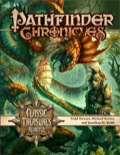
Pathfinder Chronicles: Classic Treasures Revisited (PFRPG)Paizo Inc.Print Edition Unavailable Add PDF $15.99 Non-Mint Unavailable Another great "Revisited" bookPaizo continues the trend that began with Classic Monsters Revisited. Take something cliche and beaten to death, refresh it, revamp, spit, polish and make it shine. This time, the classic D&D magic items undergo this treatment. The most commonly referenced treasures such as vorpal weapons, bags of holding or figurines of power are re-imagined in this volume. And like it's predecessors, this book is above and beyond. The ideas, backstories and variant items are just amazingly creative, fun, imaginative and well presented. Instead of scouring obscure splatbooks or pondering the 3.5 Magic Item Compendium, one can just take this book and breathe new life into the old classics. Special shout-out to my favourite Paizo author, Todd "Shemeska" Stewart, for his chapters on Well of Many Worlds and Sphere of Annihilation. Both are brilliant gems of unrestrained, crazy, creative writing. 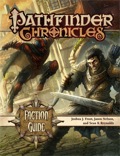
Pathfinder Chronicles: Faction Guide (PFRPG)Paizo Inc.Print Edition Out of print Add PDF $15.99 Non-Mint Unavailable An excellent surprise !Huh, now, this book is a major surprise. The moment "Faction Guide" appeared on the radar I kinda burned in my mind an image of a book with extended writeups on 6-10 major factions. And I was thinking, what's the point ? Pathfinders get their own book, Hellknights have 2 AP articles, Red Mantis were covered in parts as well, there's going to be a hell of overlap and not enough space for more obscure/new factions. I was entering the "meh" zone until I got the PDF. I am surprised. In a very good way ! The affiliation system from 3.5 PHB2 always struck me as a great idea with not enough development. What Paizo did is they took the PFS mechanics and applied them to over 20 factions, including several that I never heard of before. That's cool and smart, marrying existing mechanics with new application. Finally I have carrots to incite my players to join organizations. My only quibble with the book is that as a Chronicles book it is labeled as a GM book, while it really is a player book. 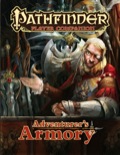
Pathfinder Player Companion: Adventurer's Armory (PFRPG)Paizo Inc.Print Edition Unavailable Add PDF $9.99 Great but scarred by errors.Ever since the 3.0 Arms and Equipment Guide faded into obscurity (and ebay archives), there was a great need for a gear book. A solid gear book that covers all fronts and plugs the holes in the default 3.5 equipment catalog. Here comes the Adventurer's Armory from Paizo. A largely system-neutral book despite being part of the Pathfinder Companion line. The book contains chapters on: Weapons & Armor, Goods & Services, Combat (introducing Equipment Tricks), Faith (religious items), Magic (alchemical spell components), Persona (an NPC alchemist) and Social (traits & feats). Most of the material is of very high quality. There are dozens of new weapons, armor and miscellaneous items, the tricks and spell components are a great new additions, and the Golarion items from PFCCS get a much-needed update to PFRPG rules. There are two things that knock a star off the rating. One of them is a relative lack of artwork for weapons, which leaves much to imagination and Internet sources. As much as it is understandable in face of 32-page limit, I would personally drop the NPC writeup and use some of the fantastic Paizo item cards artwork to illustrate the myriad of new weaponry. A bigger issue is the presence of several errors, typos and oversights. There are already several threads on Paizo forums with errata, but it does leave a sour feeling of hasty proofreading and lack of much successful public playtest. Hopefully further printings will be free of gremlins. Overall, a much needed book that delivers what it was meant to do. 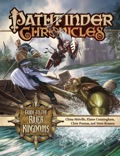
Pathfinder Chronicles: Guide to the River Kingdoms (PFRPG)Paizo Inc.Print Edition Out of print Add PDF $15.99 Non-Mint Unavailable Great writing with a littleThis book deals with the River Kingdoms, an area crammed with independent states, countries, fiefdoms, cities, towns or even villages. Setting up such a patchwork allowed Paizo to bring a whole host of authors to write about 22 areas, each of them different and unique. And the writing is, wow, excellent. From RPG veterans (John Wick, Chris Pramas, Richard Pett, the Paizo Crew), rising stars (RPG Superstar winners) to veterans of fiction (Elaine, China) the line-up is amazing and the quality rocks the house. The areas are unique, vivid and sometimes plain outlandish. However, the book has a few shortcomings. Presentation of the chapters is not standardized - some authors provided city statblocks, flags/coats of arms while others kept to pure fluff. The map is somewhat unclear and lacks detail - a poster map would be a far better move. Also, while the books is written with background material in mind, the amount of crunch is very, very small. There are next to no feats, traits, spells or equipment. Overall - great writing and excellent ideas with some slight presentation issues and a dire need for more crunchy bits. Still, it's a fantastic book and I recommend it wholeheartedly. 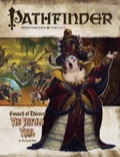
Pathfinder Adventure Path #26: The Sixfold Trial (Council of Thieves 2 of 6) (PFRPG)Paizo Inc.
Add
PDF
Print Edition Unavailable Non-Mint Unavailable Excellent !I'll be brief here: this adventure firmly establishes Richard Pett as one of the best module writers out there. And this time, he has a support sidekick madman thespian Nick Logue to boot. The concept is absolutely unique, and the execution is brilliant. The Sixfold Trial is a great way of showing that D&D is something more than a "kick the door open and kill the baddie" game. Bravo, simply bravo. 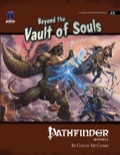
Pathfinder Module J5: Beyond the Vault of Souls (OGL)Paizo Inc.Add PDF $19.99
Add
Print Edition
Non-Mint Unavailable A great Planescape module :)Written by one of the authors of the Planescape setting line, this module is the first planar adventure in the Paizo lineup. "Beyond the Vault of Souls" features everything that made Planescape unique and vibrant, with dimensional travel, dead gods, daemons, demons, philosophy and strange answers to weird questions. It's not a dungeon crawl and it's not an urban intrigue. There's a strong feel of other-worldiness and mystery. The are no philosophy clubs here, only philosophers with clubs. No Modrons sadly, curse you Sorcerers at the Bay ! All in all, if you are a Planescape fan and/or you are looking for an unique adventure, this one is a keeper. Not up everyone's alley, but certainly up mine. Excuse me, there is a keketar protean in my garden and he sings his song of ten thousands poisons. Ohhh yes, Planescape is back. SERIOUS NOTE (really): This module pretty much expects the DM to have access to Paizo's The Great Beyond and Necromancer Games' Tome of Horrors Revised. Which is okay, as both books are all kinds of awesome.
|





